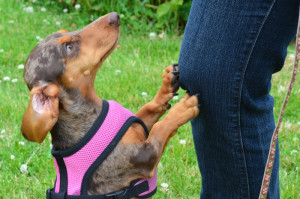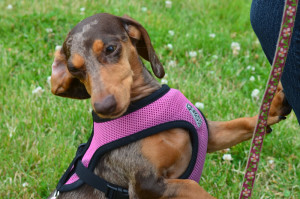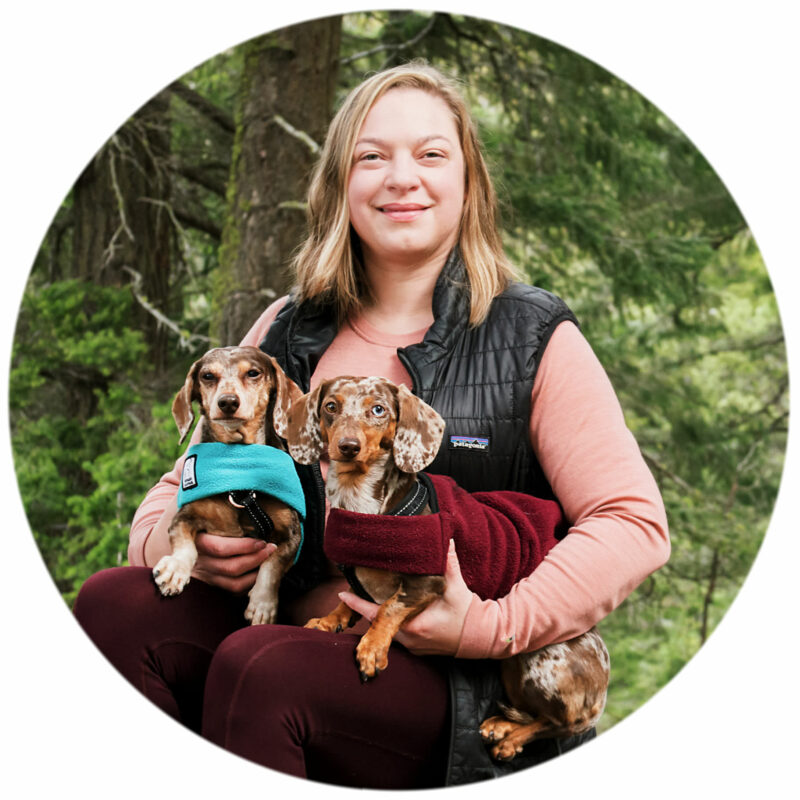THE Most Useful Thing I Learned in our Scary Dog Monster Class

Since recognizing that Gretel needed more help building confidence, being less fearful and not barking or growling on the leash I have been searching the internet for suggestions. I found a lot of stuff but much of it seemed contradictory (even within a specific training modality such as positive reinforcement) and confusing. It all made a little bit of sense though so I resorted to trying a little bit of everything.
One method I found particularly helpful was the distraction method. When practicing this, you somehow distract your dog’s attention away from the items they would react to until it passes. I was doing this with treats and got her to focus on me and soon as I spotted a potential problem. The occurrence of outburst definitely diminished.
I used this method last week when we met with our big-dog Twitter friend. I kept Gretel focused on me and she seemed less scared. She eventually let PDog sniff her without incident.
In spite of our success, I felt like we were avoiding the problem instead of addressing it. I felt like we needed more help so I took Gretel back to school.
In class I learned that the distraction technique I was using was good but there were a few elements missing that would actually help Gretel deal with her problem.
The ONE most useful thing I learned was the exercise “look at that”. In the exercise you give your dog permission to look at another dog by pointing and saying “look at that”.
When doing the exercise, it is good to use another dog that does not have the same issues as your dog. You want to avoid getting your dog worked up to the point they react.
Let this other dog get close enough that your dog will notice them. Once they do, say “look at that” and point at the dog.

Make sure your dog looks right at the other dog then ask your dog to look back at you by saying their name or holding out a treat. The idea is to get them to break there attention on the other dog. As soon as they stop looking at the other dog (they don’t necessarily have to look directly at you) give a marker (usually a click from a clicker or the voice marker “Yes!”) and feed a treat (motivator).
In this way your dog will get used to seeing other dogs without reacting. Eventually you can increase the time between when your dog looks at the other dog and you ask your dog to look back at you. I assume then at some point you can decrease the distance between you and the subject.
This is SO CLOSE to what I have been doing but I was missing the part where I asked Gretel to knowledge the other dog and then look away. I was trying to manage the issue using pure avoidance. I can’t wait to start practicing “look at that” and see if it helps.
__________________________________________________________________________________
We’re participating in this Saturday’s Pet Blog Hop hosted by Life With Dogs, Two Little Cavaliers and Confessions of the Plume. To add your blog to the hop, or to view the other great blogs participating, click one one of the host links.

About the Author
Hi, I’m Jessica. I’ve been studying the Dachshund breed since 2007, owned 3 of my own, and shared in the lives of thousands of others through their owner’s stories. When I’m not sharing what I know on this blog, you can find me hiking, camping, and traveling with my adventurous wiener dogs.

I’ve heard that Look at That is a fantastic behavioral tool (was it a Control Unleashed class that you went to, or just one that utilized LAT?) I somewhat use it for Elka, because her dog manners are not so great. She STARES at other dogs, and then is surprised when they bark at her! I’ve tried to tell her….
It was just a tool we used on leashed dogs. I was no slouch but after the class I learned to better recognize dog behaviors that will set Gretel off….and what she does to set others off. Staring is a big one. I hadn’t really thought of using LAT for that so thanks for the suggestion 🙂
What a cute dog!
Hey Chester, Hey Gretel, Jet here.
Oh that is sage advice… Mom’s gonna work with that one, too!
Good luck.
We usse clicker training with the cats at our shelter to keep the high-energy ones occupied. But I never thought to apply it to break fearful habits. Now I’m wondering if it’d work for Faraday. He gets so spooked sometimes…Hmmm….
Interesting. I have only heard of clicker training as a means of obedience training. I have never really heard of it being used just to keep your pet “busy”. Also, I find it interesting that it works on cats. It makes sense though. I almost think that cats would be more attracted to the noise than dogs.
I’ve been doing the exact same thing with Petal! Distracting her and basically avoiding the problem. She barks like mad at other dogs when they’re a distance away, but when they’re close enough to sniff, she’s quiet and has no problem with sniffing them and them sniffing her.
I’ve never heard of “Look At That!”, I’m going to have to try that! Thank you so much for sharing. 😀 You’ll have to let us know how it works for Gretel (who is, by the way, one of the cutest Dachshunds I’ve ever seen).
That’s different than what Gretel does. She is usually fine until they are close. It sounds like Petal may be barking out of frustration because she can’t get to them. As far as I know, the “look at that” exercise is primarily to make a fearful dog more comfortable. It might still work though because you would be training her to calmly look at other dogs and “ignore” them by looking back at you. I would be interested to know so please let me know if you do give it a try and it helps.
We’ve been working with Linus on being less dog reactive for years. This sounds like a good exercise for him. We’re going to give it a try we just need to find some really stinky treats to get Linus to turn his head back towards us.
I can’t wait to hear how Gretel does with her training.
I am finding it harder to practice out in the world than in class. For starters, once Gretel knows I have treats I can’t even get her to look at the other dog. Ha, ha. Also, I get distracted and forget to practice. I need to take her out somewhere with opportunities where the ONLY mission is to practice this exercise. Since you are used to training dogs in public, I am sure it will be no problemo for you 🙂
Very interesting. Sebastian used to bark at the big dogs like crazy. I started spraying him in the face with water from a spray bottle. He hated that. He stopped barking at the big dogs completely within a week. Amazing!!!
xoxoxoxo,
Erika and Sebastian
http://www.sewdoggystyle.com
Sometimes we have issues, too. If the other dog is friendly and seems interested and is a calm acting dog, I use the phrase “make a friend” to encourage the encounter with the dog. If the other dog doesn’t seem friendly I usually say, “be nice” but gently pull back on the lead to let my dog know that we are moving on and they don’t have to interact or react to the other dog.
I use “be nice” too but it doesn’t always work 🙂
I like the chance to show Gretel she is safe even when she “looks at that” then turns to you; she is learning to let go. I need to teach all my hounds people and dogs outside the yard are not excuses to bark, bay and run!
I second Gretel’s cuteness :).
She especially needs to learn to let go because she is very attached to me. On another note, is it possible to teach hounds not to bay and bark? ha, ha.
I’ve heard that gradually pressing your dog’s comfort level helps, too. I think what works for one dog doesn’t necessarily work for another and you have to do some trial and error to find what works for you and your dog! I’m glad you found something that works for Gretel! 🙂
Look at That IS a way to press your dog’s comfort level. Eventually you ask them to look at the dog longer and longer and then practice with the dog closer and closer. We will see how well it works for her though. It certainly seems promising 🙂
Mom’s gonna try this extra step at the dog park with the dogs who are the same size…thanks!
Great photos, btw…Gretel has such great expression in her face & eyes:)
Good luck. I hope it helps.
I will start practicing this with Kelly too, thanks! Although I’ve come to realize that a good deal of the problem is me. I’ve always said that she’s not friendly with other dogs because of several unexpected incidents of outbursts. So now whenever we walk, I am always on the lookout for other dogs to avoid. I’m sure she senses my anxiety. However, my husband can walk her right past most other dogs without any problem!
Well, I think what you are doing is good. Until she is comfortable, those situations that would upset her should largely be avoided. You can still be on the lookout and be very calm, confident and relaxed though 🙂 Another thing I learned in this class that could be helpful is to stop watching other dogs and pay extra special attention to your own dog’s body language. Your dog will be a better judge of what will upset them and what will not (you may avoid things that you think would upset her when in fact you could be avoiding what could be a possible positive experience for her). Also, if you see her send “I’m upset” signals you can look to see what is upsetting her (and then avoid of course). Done enough times, you will know exactly what her triggers are and what kind of training she needs.
Good luck! I know this game helped us a lot with reactivity. It is something that sounds so simple, isn’t it? I found most of my dog training has been filled with “duh” moments. As in, how did I not know this before?
It sounds like you and Gretel are at the start of something awesome!
I think that is what I like about it so much. It’s simple. The biggest challenge for me is actually getting Gretel to look anywhere but my hand when I have a treat in it. Ha, ha.
That sounds like an excellent training technique. It sounds like something good for the handler as well as the dog. I think sometimes people are so worried about their dogs acting up that they get nerved up rather than staying calm. This is sort of a teamwork thing.
Yes, staying calm is the key. I usually do pretty good. However, I do get tense once she actually reacts so I always have to work on that.